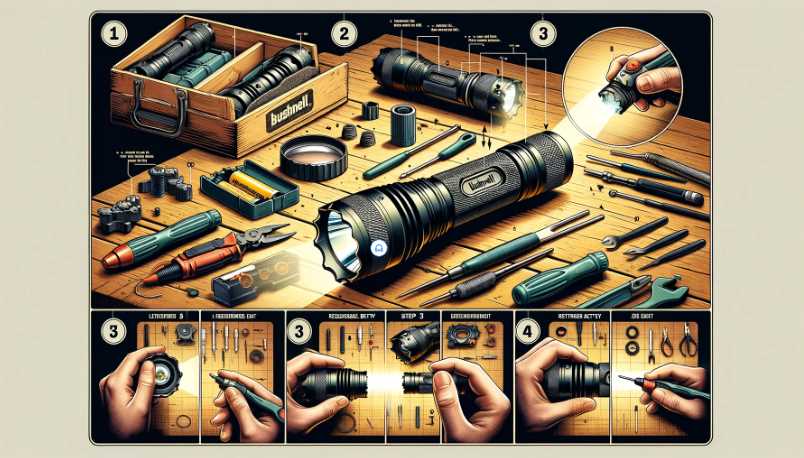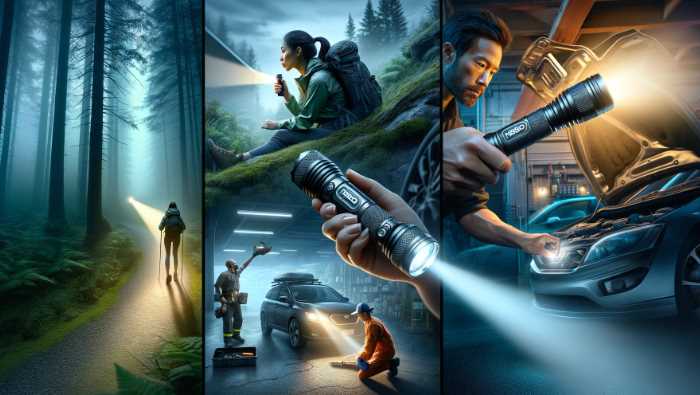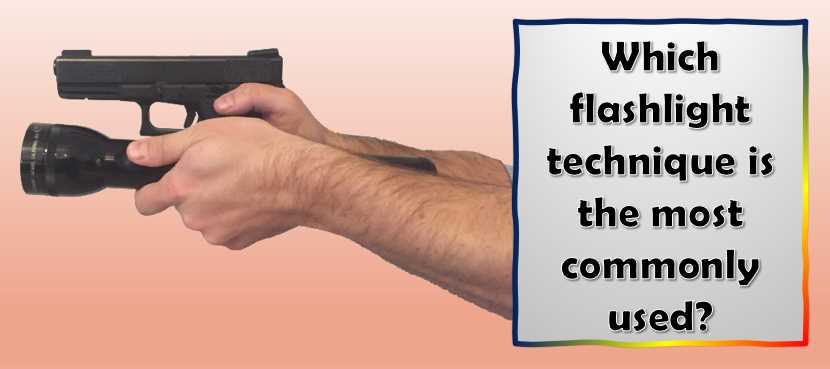Meanwhile, we all know a flashlight is one of the most important essentials when going out at night. But, even with the best flashlight in your hand and knowledge of how it works, it may be a bad idea if you don’t know how to take it apart safely. While there are some precautions you must be aware of while following the guide, taking apart your flashlight isn’t a big deal.

Here are some tips on how to do it safely:
Always use gloves before handling these batteries as they tend not to hold their charge well and might leak if dropped or mishandled.
Keep all other items away from the battery so as not to create a risk of developing an explosion.
Make sure that no tools or heavy objects come into contact with batteries when they are being disassembled.
And finally, don’t leave any battery parts inside your pocket because they may cause burns if accidentally swallowed.
We’ll also teach you how to keep your Bushnell flashlight running smoothly and securely using regular maintenance procedures. So whether you’re a novice or an experienced Bushnell flashlight user, this article is for you!
Tools and Materials

Before embarking on the disassembly journey, gather the necessary tools and materials to ensure a smooth process. Here’s a quick list:
| Tools | Materials |
|---|---|
| Screwdriver set | Clean cloth |
| Tweezers | Rubbing alcohol |
| Pliers | Small brush |
| Safety gloves | Container for small parts |
| Safety goggles | Replacement components |
Make sure you have a well-lit and organized workspace to prevent any accidental misplacement of small components.
Understanding the Flashlight Components
A Bushnell Rechargeable Flashlight comprises several key components that work together to produce a reliable light source. Understanding these parts is essential before attempting disassembly:
- Outer Casing: The flashlight’s protective shell, often made of durable materials like aluminum or plastic.
- Battery Compartment: Holds the rechargeable battery that powers the flashlight.
- LED Module: The light-emitting diode responsible for producing illumination.
- Circuit Board: Manages the electrical flow and controls the flashlight’s various modes.
By familiarizing yourself with these components, you’ll approach the disassembly process with confidence.
5 Steps for Safe Disassembly
Follow these steps for a safe and effective disassembly process:
Power Off and Battery Removal
Before starting, turn off the flashlight and remove the rechargeable battery. This ensures your safety and prevents accidental electrical shocks during the disassembly.
Disassembling the Outer Casing
Use the appropriate screwdriver to remove any screws securing the outer casing. Place the screws in a container to avoid misplacement. Gently pry open the casing, taking care not to damage the internal components.
Removing Internal Components
Once the casing is removed, identify and gently detach the LED module and circuit board. Note the arrangement of components for easier reassembly later.
Dealing with Circuitry and Electronics
Handling the flashlight’s electronics requires caution:
- Understanding Flashlight Electronics
Bushnell flashlights often have advanced circuitry. Familiarize yourself with the circuit board layout and the functions of each component.
- Precautions for Handling Circuit Boards
Wear safety gloves to protect against static electricity. Avoid touching circuitry with bare hands, as oils and debris can damage sensitive components.
- Disconnecting Wires and Components
Carefully disconnect wires linking the LED module and circuit board. Use tweezers for precision, ensuring minimal stress on delicate connections.
Cleaning and Maintenance

Regular cleaning is vital for optimal flashlight performance:
- Importance of Regular Cleaning
Dust, debris, and moisture can accumulate over time, affecting the flashlight’s efficiency. Regular cleaning ensures maximum light output.
- Recommended Cleaning Agents
Use a clean cloth and rubbing alcohol to wipe down components. For stubborn dirt, a small brush can be employed. Ensure all parts are thoroughly dry before reassembly.
- Inspecting for Wear and Tear

While cleaning, inspect components for signs of wear or damage. Replace any worn-out parts with suitable replacements to maintain the flashlight’s longevity.
| Part | Condition | Action |
|---|---|---|
| LED Module | Dirty or damaged | Clean or replace |
| Circuit Board | Signs of wear or damage | Replace if necessary |
| Outer Casing | Scratched or dented | Consider replacement |
Common Issues and Troubleshooting
Despite their reliability, Bushnell flashlights may encounter common issues:
- Identifying Common Problems
Common issues include flickering lights, unresponsive buttons, or water damage. Identifying the problem is the first step in effective troubleshooting.
- Troubleshooting Tips
Refer to the user manual for specific troubleshooting guidance. In most cases, issues can be resolved through simple solutions like battery replacement or resetting the circuit board.
- Repair vs. Replacement Considerations
Evaluate the severity of the issue. Minor problems can often be repaired, but extensive damage may warrant component or flashlight replacement.
Reassembly Process

After addressing any issues, it’s time to reassemble the flashlight:
A. Organizing Disassembled Parts
Arrange all components in the order they were removed. This organization streamlines the reassembly process.
B. Step-by-Step Reassembly Instructions
Follow these steps to ensure a smooth reassembly:
- Reconnect the wires between the LED module and circuit board, using tweezers for precision.
- Place the circuit board back into its designated position, ensuring proper alignment.
- Carefully insert the rechargeable battery into the compartment, observing the correct polarity.
- Align the outer casing and secure it with the previously removed screws.
C. Ensuring Proper Alignment
Check that all components are securely in place and aligned correctly. A misaligned component can lead to operational issues.
IX. Testing the Flashlight
Before declaring the job done, thoroughly test the flashlight:
A. Preparing for Testing
Ensure the battery is fully charged before testing. This step verifies that all components are functioning correctly.
B. Safety Measures during Testing
Wear safety goggles during the initial test to protect against unexpected malfunctions. If the flashlight operates as expected, the reassembly was successful.
C. Common Testing Issues and Solutions
If issues persist, refer back to the troubleshooting section or consult the user manual for guidance. Persistence of problems may indicate a more complex issue requiring professional attention.
10 Tips to take apart a Bushnell rechargeable flashlight
There are a few different ways to take apart a Bushnell rechargeable flashlight. The most common way is to remove the battery cover and unscrew the light body. To replace the battery, you need to remove the screw at the base of the body and replace it with an included lithium-ion cell.
If you’re looking to take apart a Bushnell rechargeable flashlight, here are the eight steps you need to follow:
1. Disconnect the battery by unscrewing the base of the light and pulling it outwards.
2. Remove the lens cover by gently pushing on one side and then lifting it off. You might need to use a small screwdriver to pry it off its retaining ring (see circled area).
3. If there are any stickers or other markings on the inside surface of either lens, remove them now with your fingernail or an adhesive remover pen before proceeding further (they will come right off). Be careful not to scratch either lens! Just ensure that you wipe down both lenses afterward so that any residual adhesive doesn’t interfere with their performance when putting them back together again.
4. Flip each glass component over so that they’re facing inwards, and unscrew each one from its mount using a Phillips head screwdriver (or equivalent) – keeping track of which is which as you go! Don’t overtighten these screws, though – just enough for them to be stable once they’re removed but still able to move within their respective mounts if needed:
5. Once all the screws have been removed, the two halves of the light can be gently pulled apart.
6. Don’t try to do this with both hands at once – it’s better to use one hand to hold each end of the light while you twist/pull on the other to avoid damaging either lens or housing…
7. If there are any seals around battery contacts and switches, break them open using a blunt object like a credit card (or even your finger if necessary) before removing these parts from their mounts.
8. Make sure that no debris remains inside these cavities after doing so.
9. Once all the components have been removed, you can start to clean them up. Use a soft cloth or cotton swab dipped in isopropyl alcohol (IPA) to remove any dirt, dust, and fingerprints – being careful not to scratch either lens, of course!
10. Finally, reassemble the light by reversing steps 2-7. Make sure that each lens is positioned in its correct orientation before screwing it back into place on its mount (see circled area). And don’t forget about the adhesive sealant – ensure it’s applied adequately around both lenses before reassembling!
Repairing Methods and Considerations of Bushnell rechargeable flashlight

There are many repair methods and considerations for Bushnell rechargeable flashlights. It is highly recommended to use a charger with a good rating for the light’s size and type of battery so that it will be charged appropriately and last longer. Additionally, clean the lens after each use with a microfiber cloth or water droplet, just as you would your cellphone screen.
1. Not all flashlights are created equal, and some may not be suitable for use in repairing objects because of their high levels of electricity or intense light. Read the product reviews and research which flashlight is recommended before making a purchase.
2. Always use caution when working with any electric device, especially if you are not familiar with how it works or if repairs aren’t correctly done, they could lead to severe accidents or injuries- even death! Follow all safety guidelines that come with your flashlight to avoid any mishaps.
3. Keep the battery charger nearby if you need to charge the flashlight quickly during repairs; this will help reduce downtime while work is being done on an object.
What tools do I need to repair the Bushnell rechargeable flashlight?
When repairing the Bushnell rechargeable flashlight, you will need a few essential tools. These include a Phillips screwdriver, seam ripper, knife, and pliers. Additionally, you may want to have some waterproof, non-stick tape or bonding adhesive ready in case of accidents.
To repair the light itself, first unscrew the screws that hold down the reflector and lens cover. Afterward, use your knife to slice off any excess material around these two pieces so they can be replaced easily. After this is done, reattach the reflector and lens cover using your Phillips screwdriver. Make sure they are adequately screwed in place before replacing the battery unit by following directions from Bushnell’s website or user manual if available.
Final Words:
Now that you have digested the entire post, we hope you know how to handle a Bushnell rechargeable flashlight. It is not hard to fix the charging issue; however, if your flashlight does not start working properly after replacing the battery, you can expect some troubleshooting.
We hope this guide helped you in taking apart a Bushnell rechargeable flashlight!















